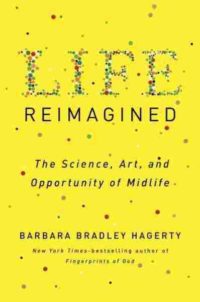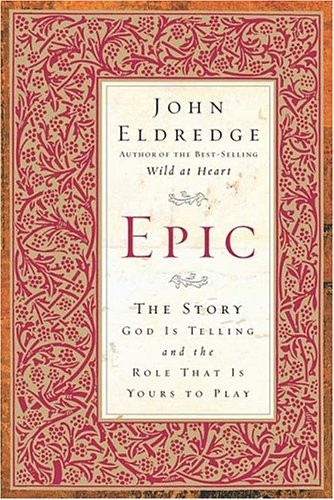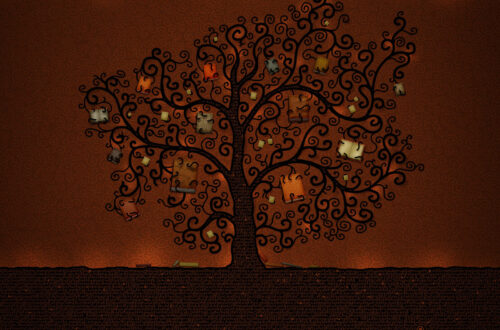Life Reimagined
 I discovered Barbara Bradley Hagerty’s Life Reimagined: The Science, Art, and Opportunity of Midlife in this article about how our experience of our faith changes as we mature. The book explores that long stretch of years we call middle age — from around 45-65 — and the perspective shifts, professional landscape, brain chemistry, and changing values associated with it.
I discovered Barbara Bradley Hagerty’s Life Reimagined: The Science, Art, and Opportunity of Midlife in this article about how our experience of our faith changes as we mature. The book explores that long stretch of years we call middle age — from around 45-65 — and the perspective shifts, professional landscape, brain chemistry, and changing values associated with it.
I really enjoyed the book, despite a few aspects that bothered me. Do you want the good news, or the bad news, first? Since my overall experience was good, I’m going to get the complaints out of the way first, and save the best for last.
- Though it’s possibly a minor point, Hagerty gets Malcolm Gladwell’s Outliers totally wrong. She makes mention of it when discussing Eric Ericsson’s research about the importance of practice. In a note, she adds this qualifier: “See Malcolm Gladwell’s book Outliers, which argued that talent is unnecessary as long as you practice ten years or ten thousand hours.” Sorry, but I’ve read Gladwell’s book twice. It doesn’t say that at all. It simply explores the factors in addition to talent that pertain to highly successful people. Her erroneous summary made me wonder how many other things she may have gotten wrong that I wouldn’t happen to know about.
- The book never confronts the dilemma of causation vs. correlation. It points to many factors relevant to aging well, and the implication seems to be, “Do these things to achieve the same result as these people.” But do the habits — exercise, ongoing learning, novelty in marriage — cause the experience, or are they results in the life of someone who’s already aging well? Ultimately one’s quality of life boils down to our choices, and here we are in the realm of mystery. The title points to “science,” but while brain chemistry is an interesting factor, will may be the true rudder.
So much for criticism. What I liked far outweighed these niggling negatives.
For one thing, the book affirms common experiences, alleviating potential isolation. Age discrimination and financial struggle seem to be common experiences for those in mid-life, for example. Hagerty reports on an informal study conducted through the NPR website, one in which she simply asked, “How’s midlife treating you?” Many, many of the responses, even from the educated professional class that makes up NPR’s audience, testified to huge financial losses and job losses. Our tiresomely unanimous, uncritical news media keep insisting that this is a strong economy, the best we’ve had in years. But this is not borne out in the experience of many actual people.
For another thing, I enjoyed reading about the many factors that relate positively to aging: exercise, new learning, incorporating new experiences in marriage, volunteering, attitude, social life, purpose. The midlife crisis, it seems, is more myth than reality, and not necessarily a common experience for the majority. It was inspiring to read about the people Hagerty interviews as well as the ways she participates in her own research. In the course of the book, Hagerty
- becomes an avid cyclist and enters the Senior Olympics (exercise/purpose);
- participates in a brain study that involves working on particular mental tasks for a period of time and demonstrates measurable growth (neuroplasticity and memory);
- rents an RV and goes on an extended camping trip with her husband (marital exploration) and another couple (social life);
- and, ultimately, takes an NPR buyout and switches careers from reporter to author (finding purpose/meaningful work).
Structurally the book intersperses research, interviews, and personal experience in an engaging way. Hagerty is an entertaining writer who can explain technical material in clear and interesting prose.
As someone with Alzheimers firmly established in my genetic inheritance, I was delighted to learn that there exist people whose brains have the “plaques and tangles” of the disease, but none of the symptoms. I had no idea! What better testimony that it isn’t exclusively an issue of genetic determinism, but of lifestyle choices as well, whether a person falls victim to this tragic disease.
While I was glad to discover that I’m already incorporating a number of the “good habits” of productive midlife, there is one glaring weakness: friendships. I have a healthy marriage and family life, but when it comes to friends, well…. I would say I have many acquaintances, but few real friends at this point in my life. Much of this has to do with time and energy, most of which is focused on my family. But as my children grow older and more independent, this book reminds me that it’s important to look for opportunities to develop friendships. This isn’t what I’d call an area of natural strength for me; I’m definitely an introvert, which doesn’t mean I’m antisocial, but does mean I’m comfortable alone. Yet interestingly, Hagerty’s discussion reminds us that cultivating friendships is a major factor in physical and mental well-being — one worth the risk and effort necessary.
Finally, the book inspires me to “reimagine” a professional direction for my own life. Hagerty focuses on the professional class: those who climb the ladder of success in their careers and then change course in mid-life. I’ve been outside of any professional structure for some time now; I didn’t get very far up the ladder before changing course 15 years ago, leaving a tenure track teaching position at the beginning of my academic life to marry, then become a parent, then home educate my kids. I reach mid-life with education, experience and skills, yet when it comes to any clout in my professional sphere, well… I’m not sure how to make it translate. I was just starting out in academia when family rose to prominence. I have loved the transitions:
- from academic publication to blogging;
- from college level instruction to educational jack-of-all-trades with pre-college-aged students;
- from a teacher:student ratio of 1:25 or 1:50 to 1:1;
- from uncovering themes in American and British lit to reading all kinds of books together with my kids, noticing and thinking about literary elements together in the process;
- from an “expertise” to omnivorous reading.
But none of this has occurred in a professional sphere with LinkedIn contacts and professional evaluations or promotions. As the end of my homeschooling era comes into view a few years down the road, I find myself mulling how to identify and channel the strengths I’ve developed in new directions.
If you’re somewhere on the long road of midlife, I recommend Life Reimagined. It’s a source of enjoyment, information, and enlarged perspective that I savored. It provides its target audience with some useful materials to think about quality of life, goals, and dreams, and Barbara Bradley Hagerty makes a great guide along the way.



6 Comments
Ruth
This does sound good. I so often wish we lived closer, so we could be friends at this stage in our lives the way we were in college.
Janet
I would love that too! Maybe it will happen someday. I refuse to rule out that kind of dream.
Barbara H.
Sounds interesting! I am right in that age bracket and have wondered what life will be like when my husband retires, the financial and health and insurance situations. There is biblical precedent both for planning ahead and for faith rather than anxiety – trying to find the balance between it all.
Interestingly, I am the same boat with friendships. I’ve never had a whole “posse,” but I’ve usually had one good friend and another one or two that I’d feel comfortable going out to lunch with. I do have people I could call for a lunch get-together, but I just don’t have the desire or energy right now. I’m attributing that to having my m-i-l in our home along with her caregiver and hospice people – I’m on people overload much of the time. But that’s not the same thing as friendships. Plus due to that situation we’re not as free to go to many church functions, which is where I have always felt I got to know people more than on Sunday mornings. So in many ways we feel a little isolated. I’m thankful for outlets for that online, but then again, it’s still not the same as with people in everyday life.
I’m very much a creature of habit, and can get rattled when a new procedure or event or route or whatever comes up. But I tell myself it’s good for my brain to be challenged and to do things differently sometimes, and that helps a bit. :-)
Janet
Yes, I can see how “people overload” is a factor right now… There are definitely seasons when cultivating friendships is harder.
hopeinbrazil
This is a good review of a book I haven’t heard of before. Thanks for your insights.
Pingback: